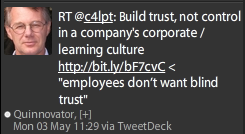“Social Networks are fundamentally connected to goodness, and what the world needs now is more connections.” Nicholas Christakis
“I believe that the more time we spend choosing to run the deep inner-peace circuitry of our right hemispheres, the more peace we’ll project into the world, and the more peaceful our world will be.” Jill Bolte Taylor
“When people of all different persuasions come together working side be side for a common goal, differences melt away and we learn amity and we learn to live together and to get to know one another. Karen Armstrong”
I have a contrarian side to me, and whenever I see hyberbole like this my snarky side switches on. Besides, I’m wikid tired right now so I’m not in my usual upbeat and bright-side mood.
Relational Proximity Dimension #5 is Purpose/Commonality: Our sense of connectedness and relationship is greater to the degree we have things in common or share a common purpose or identity. A good relationship has a direction to it, something that is common between the members that holds it together.
There’s rarely been a TED (www.ted.com) talk I didn’t enjoy and which didn’t fascinate me. It’s a great platform, wonderfully presented, and the technology, the discovery or the personal experience is invariably gripping and exciting. And what they’ve done to spread the ideas and concept is excellent. It has been accused and defended of elitism. Personally, I think it’s a fantastic way to make use of rich people’s money and to spread great ideas. If anything, however, the problem is that the speakers just can’t seem to help overstating their point. With an audience paying six grand a pop, just 20 minutes to pour out your life’s work, the spotlights … I can’t say I wouldn’t do the same.
But I also think they and their audience actually might believe their overstatement. Unfortunately the overstatement takes the talks from being mostly excellent, scientifically grounded and true-to-life to, well, amazingly utopian wishful thinking. (I speak as an idealist myself). Jill Bolte Taylor’s amazing description of watching her own brain have a stroke (truly, jaw-droppingly amazing) ends with an apparent choice between left brain individualism or right-brain universal life-force. My emotional & violent right brain freaks me out sometimes. And what part of the brain is the ‘we’ that’s doing the choosing anyway? Nicholas Christakis asserts that connections will solve the world’s problems. Connections like the Stazi had? Like the world banking system had?
And Karen Armstrong’s talk seemed grounded neither in anthropology nor anything like a robust theology. The ending actually I agree with (“get to know each other” would presumably comes first – I’m sure it wasn’t her best line, she looked exhausted). But the ‘common purpose’? It’s the “Compassion Charter” signed up to by 46,179 compassionate people so far. Sorry if you’re a fan but isn’t the problem uncompassionate people?? And I don’t want differences between me and others to go away, I want them transcended. I’m not saying we couldn’t do with more love, but not even the 10 commandments prevented human ingenuity for evil. A group of people simply agreeing to be more compassion isn’t, I’m desperately sad to say, going to solve our deepest problems. I totally commit to be being more compassionate. Then another day happens. As Solzenitsyn said, “the line separating good and evil passes not through states, nor between classes, nor between political parties either, but right through every human heart, and through all human hearts. This line shifts. Inside us, it oscillates with the years. Even within hearts overwhlemed by evil, one small bridgehead of good is retained; and even in the best of all hearts, there remains a small corner of evil.”
I love and appreciate the longing for peace and goodness and love in these people and in their statements. The confirmation of relational proximity found in these social science, neuroscience and and humanistic statements I wholeheartedly welcome. But, firstly, mere ‘relational proximity’, socially networked togetherness, isn’t the whole answer; it just points the finger more acutely on the problem. I’ve said (in the 30-day index) that the five dimensions of relational proximity are nothing without love and commitment, and that love and commitment can barely consist without them. That’s why relational proximity I think is so powerful, and so much more powerful than nebulous ‘social networks’. If used to examine our lives, I think it reveals the reality of our choices and our relationships. Secondly, the that these connections are FOR something is crucial. What is the common purpose? Christakis says in his video that our global human network is a super-organism, it has a life of its own. I think world peace and compassion are good goals, but I actually think they’re penultimate; they’re derivative of something bigger, something, perhaps someone, more creative and dynamic and Personal.
And that is way too much thinking for one night. See below for all three videos and let me know what you think?







